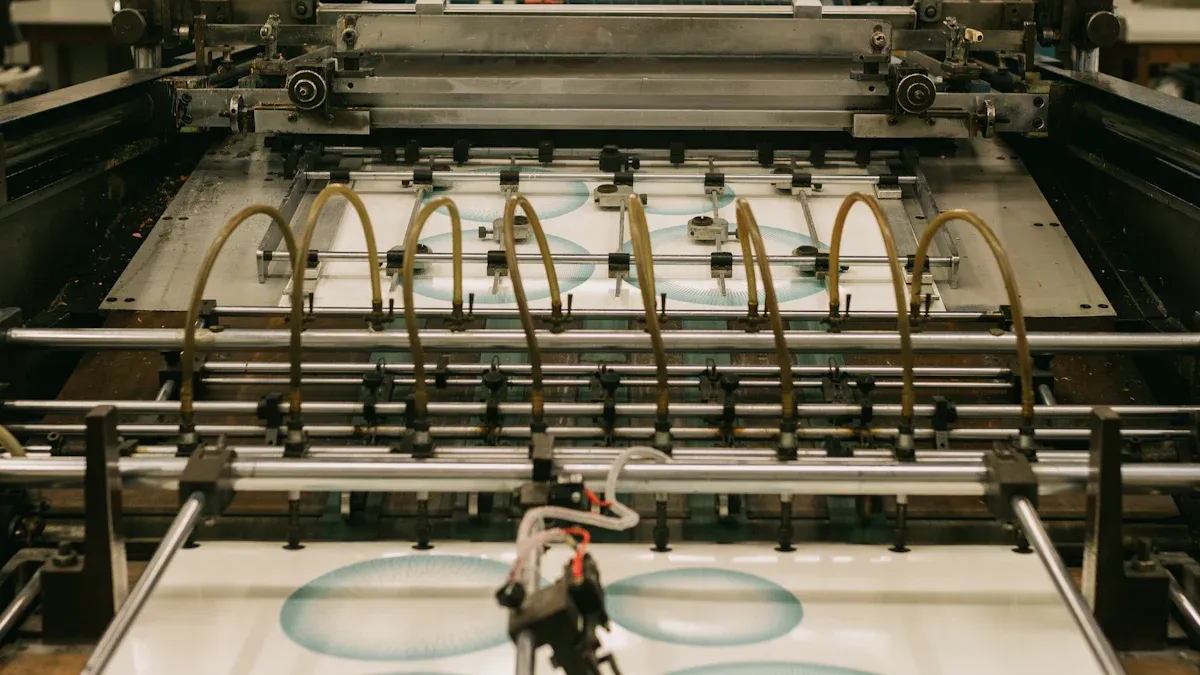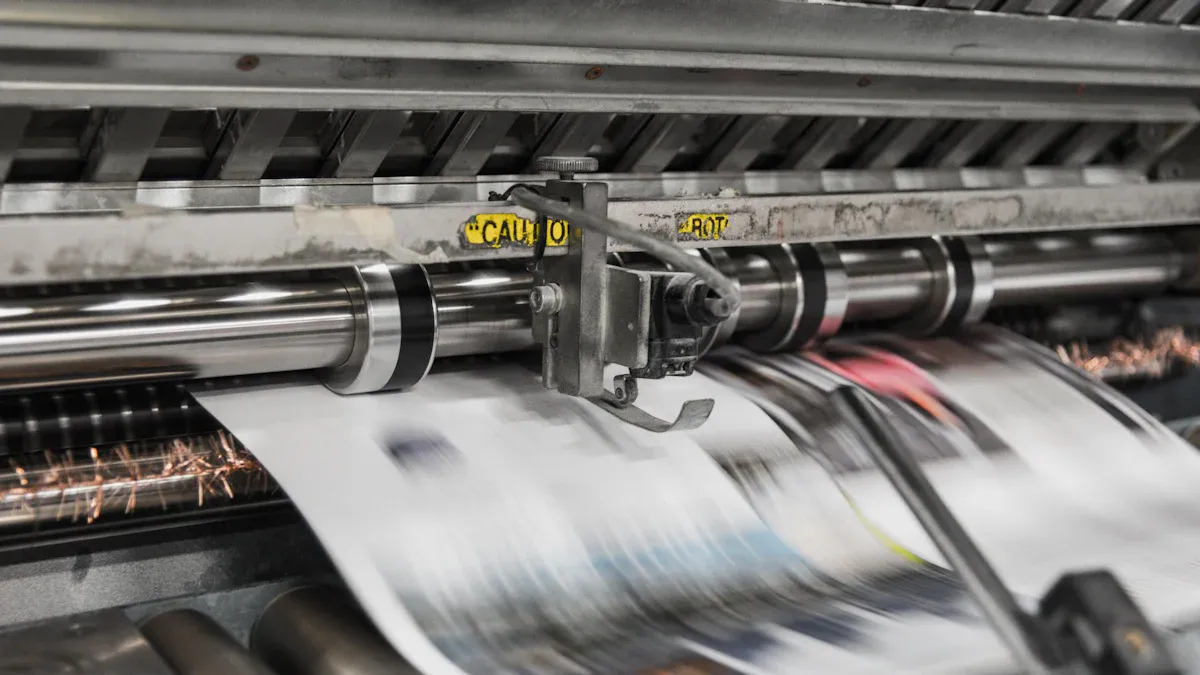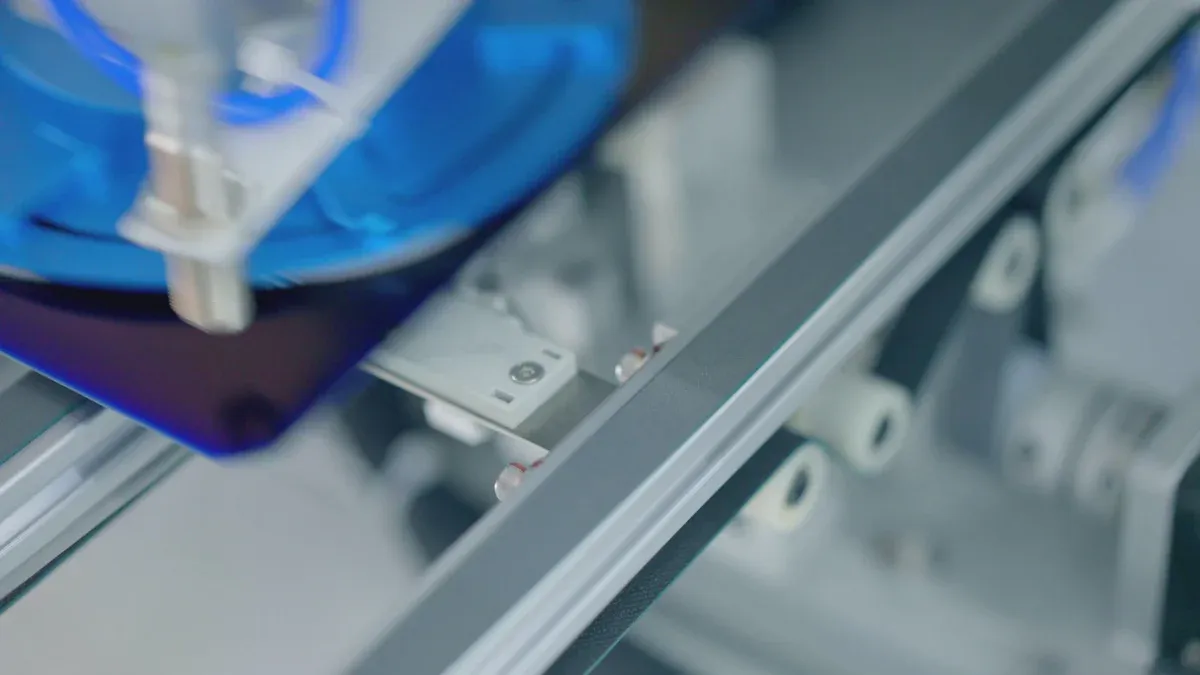What Makes Automatic UV Coating Machines Essential for High-Speed Printing

Automatic UV Coating Machine technology delivers rapid curing and a superior finish. Print shops see clear benefits:
- Increased resistance to scratches, smudges, and fading
- A protective layer that extends print life and reduces complaints
Efficient ink management also cuts material waste, lowers energy costs, and supports eco-friendly practices.
UV Coating Machine Impact on Speed and Efficiency

How Automatic UV Coating Works
Automatic UV coating machines rely on a combination of advanced mechanical and chemical processes to deliver precise and durable finishes. The chemical process begins with a specially formulated liquid containing oligomers, monomers, photoinitiators, and additives. When exposed to high-intensity UV light, photoinitiators trigger rapid polymerization, transforming the liquid into a solid protective layer almost instantly.
Mechanically, these machines use fluid handling systems with stainless steel or Teflon components to prevent chemical corrosion and defects. Opaque fluid lines protect the coating from premature curing caused by ambient light. Pumps designed for shear-sensitive coatings, such as diaphragm or peristaltic pumps, maintain the integrity of the fluid. Inline heaters control temperature, reducing viscosity for smoother application. Electrostatic rotary atomizers utilize centrifugal and electrostatic forces to evenly distribute the coating and enhance transfer efficiency. Operators can adjust parameters like fluid flow rate, atomization air pressure, and voltage to ensure consistent thickness and quality. Compact UV curing chambers replace bulky thermal ovens, saving valuable floor space in print shops.
Tip: Automated substrate feeding and real-time monitoring further streamline the workflow, reducing manual intervention and ensuring uniform results.
Immediate Production Speed Gains
Automatic UV Coating Machine technology delivers significant improvements in production speed compared to manual methods. Automation synchronizes feeding, coating, and curing processes, allowing for continuous operation and minimal downtime. The following table highlights speed benchmarks for leading models:
| Manufacturer | Model/Series | Speed Benchmark | Notes |
|---|---|---|---|
| Eureka Machinery | SD-1050W | Up to 9000 sheets/hour | Speed varies by sheet weight, size, quality |
| Autoprint | General UV coating machines | 2000 to 6500 sheets/hour | Includes spot coating machines |
| Autoprint | Fine Coat 80 | 2000 sheets/hour | Automatic UV coating machine |
| NEW STAR | High-speed models | Up to 100 sheets/minute | Ideal for large-scale printing enterprises |
| NEW STAR | Small Automatic UV Coating Machine | Around 60 sheets/minute | Focus on cost saving and environmental impact |
Operators in high-volume environments benefit from these speed gains, which translate into higher throughput and faster turnaround times. Automated thickness control and substrate compatibility features optimize workflow, ensuring that each print receives the correct coating without delays.
Consistency and Reduced Errors
Consistency remains a critical factor in high-speed printing. Automatic UV coating machines incorporate several features that minimize errors and maintain uniform quality. These machines use automatic feeding systems with strong pressure supply to prevent paper falls and ensure continuous transmission. Rectification belts keep the paper aligned, reducing mechanical faults. Sensors detect misfeeds and stop rollers to avoid damage. One-button controls simplify operation, reducing human error. Paper counters allow operators to monitor output and identify issues early. Floating paper designs ensure only one sheet passes through at a time, preventing jams or double feeds. Navigated pressure systems and paper stoppers guarantee smooth movement and neat output.
Dow’s Integrated Research Imaging Solution provides objective metrics for evaluating coating consistency. Standardized imaging and AI algorithms measure color differences, texture, and defects with high precision. The following table summarizes key consistency metrics:
| Consistency Metrics Used | Description and Role |
|---|---|
| Glossiness | Indicates coating barrier quality after UV aging and salt spray cycles |
| Yellowness | Measures color change due to degradation |
| Water Contact Angle (WCA) | Assesses surface hydrophobicity and coating integrity |
| Adhesion | Evaluates strength of coating adherence |
| Electrochemical Impedance Spectroscopy (EIS) | Quantifies coating barrier properties using impedance modulus |
Machine learning models analyze these metrics to predict performance and classify damage states, supporting reliable and reproducible results. Print shops achieve higher consistency and fewer errors, which leads to reduced waste and improved customer satisfaction.
UV Coating Machine Advantages for Print Quality and Durability

Instant Curing and High-Gloss Finishes
UV Coating Machine technology transforms the finishing process by delivering instant curing. When operators apply UV-curable coatings, the material hardens within seconds under ultraviolet light. This rapid process eliminates the need for extended drying times, which often slow down traditional print production. As a result, print shops can move jobs quickly from coating to cutting, packaging, and shipping. In industries such as electronics and automotive, instant curing allows production lines to process hundreds of items per hour, dramatically increasing throughput and reducing bottlenecks.
The instant curing process also produces a high-gloss finish that enhances the visual appeal of printed materials. The coating forms a smooth, reflective surface that intensifies colors and sharpens images. This glossy effect not only attracts attention but also adds a premium look to brochures, packaging, and marketing materials. Print shops benefit from the ability to deliver high-quality products faster, meeting tight deadlines and exceeding customer expectations.
Note: The integration of AI-driven defect detection in some UV Coating Machine models further improves finish quality by identifying and correcting imperfections in real time.
Enhanced Abrasion and Chemical Resistance
Durability stands as a key advantage of UV-coated prints. Laboratory tests, such as the Sutherland rub tester and Taber Abraser, demonstrate the superior abrasion resistance of UV-cured coatings. These tests simulate real-world wear by rubbing or abrading the coated surface under controlled conditions. Results consistently show that UV-coated prints withstand more rubs and exhibit less wear compared to conventional finishes.
- The Sutherland rub tester measures how many cycles a print can endure before showing signs of abrasion, making it relevant for materials that face frequent handling.
- The Taber Abraser evaluates wear resistance by rotating abrasive wheels over the surface, providing insight into long-term durability.
- The GA-CAT Comprehensive Abrasion Tester combines multiple factors to simulate practical use, assigning wear rankings that reflect real-world performance.
These rigorous tests confirm that UV-coated prints resist scratches, scuffs, and chemical exposure. The protective layer shields the underlying ink and substrate, ensuring that colors remain vibrant and text stays legible even after repeated handling. This level of durability proves essential for applications such as packaging, business cards, and catalogs, where products must maintain their appearance throughout their lifecycle.
Cost-Effectiveness and Waste Reduction
Automatic UV Coating Machine systems deliver significant cost savings for print shops. By automating the coating process, these machines reduce the need for manual labor. Many shops report that operator requirements drop from two people to just one, thanks to digital controls and servo-driven mechanisms. Maintenance-free features, such as automatic refueling and robust roller designs, further lower operational costs by minimizing downtime and repair needs.
Print shops also benefit from reduced ink and material consumption. UV Coating Machine technology applies coatings with precision, minimizing overspray and waste. Faster job completion times mean that shops can handle more orders in less time, increasing overall productivity. Access to affordable replacement parts and inks helps maximize return on investment.
- Lower labor costs due to reduced operator requirements
- Decreased maintenance expenses from durable, self-lubricating components
- Less material waste through precise application and efficient use of coatings
- Faster turnaround times, enabling higher throughput and improved customer satisfaction
These advantages make UV Coating Machine technology a smart investment for businesses seeking to boost efficiency, cut costs, and support sustainable practices.
UV Coating Machine in Commercial Printing Applications
Real-World Performance and Case Studies
Automatic UV coating machines have transformed commercial printing by delivering faster production speeds and higher-quality finishes. For example, a leading packaging company implemented intelligent control systems in their LED UV curing process and saw a 25% increase in production speed. Print quality improved, and energy costs dropped by 40%. In another case, a publishing house enhanced book jackets with UV coating, resulting in vibrant color and gloss that attracted more customers. E-commerce packaging firms also reported improved brand perception and customer loyalty after adopting automatic finishing equipment. These real-world examples show how UV coating technology boosts both efficiency and product appeal.
Maintenance and Reliability for Continuous Operation
Consistent performance in commercial printing depends on regular maintenance. Operators should clean machines to remove dust and varnish buildup, inspect components for wear, and replace parts as needed. Periodic calibration of sensors and software ensures accurate application. The following table outlines a recommended maintenance schedule:
| Maintenance Interval | Key Tasks |
|---|---|
| Monthly | Inspect belts, clean and lubricate gears, check sensors, clean filters |
| Quarterly | Clean filters under machine, lubricate hinges |
| Bi-Annual | Inspect mechanical components, lubricate moving parts |
| Annual | Full system inspection, replace worn parts, update software, operator training |
Following these steps helps prevent breakdowns and extends the operational life of the equipment.
Supporting High-Volume, High-Quality Output
Commercial print shops rely on UV coating machines to handle large orders without sacrificing quality. Machines like the FHSGJ-1050 can process up to 9,000 sheets per hour. Features such as automatic feeding, air knife systems, and servo-motor controls ensure uniform coating and consistent results. Operators can quickly switch between gloss, matte, or satin finishes to meet diverse client needs. The technology supports a wide range of substrates, including paper, cardboard, and specialty packaging materials. By maintaining high standards during high-volume runs, these machines help businesses deliver durable, visually appealing products on tight deadlines.
- Print shops gain a competitive edge by adopting automatic UV coating machines.
- Businesses benefit from faster production, improved surface quality, and lower energy use.
- Industry trends show rising demand for eco-friendly, high-performance coatings.
Investing in this technology supports growth, sustainability, and long-term cost savings.
FAQ
What types of materials can automatic UV coating machines handle?
Automatic UV coating machines process a wide range of substrates. These include paper, cardboard, synthetic sheets, and select plastics. Operators achieve consistent results across various print applications.
How does UV coating improve print durability?
UV coating forms a hard, protective layer. This layer resists scratches, moisture, and fading. Printed materials maintain their appearance and integrity during handling and storage.
What maintenance does a UV coating machine require?
Operators should clean rollers, check sensors, and inspect belts regularly. Scheduled maintenance ensures reliable performance and extends the machine’s operational life.
See Also
Top Folder Gluer Innovations Shaping Carton Lines In 2025
Ways Plate Air Preheaters Boost Efficiency In Industrial Settings
Six Essential Industrial Vacuum Cleaners Businesses Must Evaluate
Comparing Leading Manufacturers Of Ampoule Filling Production Lines